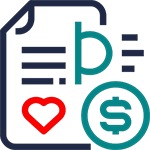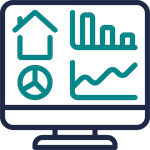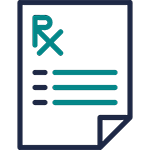For healthcare providers in the U.S., navigating the medical billing landscape is akin to solving a multifaceted puzzle.
There are problems like staying updated with the coding guidelines, claims denials leading to financial strain, medical coding and billing errors, and whatnot!
But this article here delves into the three primary billing challenges faced by healthcare offices, as identified by the complaints about medical billing we’ve received from our clients.
1. Understanding and Adapting to Constant Regulatory Changes
The healthcare industry is perpetually under the microscope of regulatory changes. In 2021, the American Medical Association (AMA) released 329 new CPT codes, underscoring the dynamic nature of healthcare billing.
Keeping up with these changes is a herculean task for any health office. Failure to stay current often leads to claim rejections and denials, directly impacting the revenue cycle.
Solution: Continuous Education and Utilization of Technology.
To stay ahead, invest in regular training for your billing staff, and slash all billing issues.
Embrace technology solutions like updated Electronic Health Records (EHR) systems that integrate new codes and regulatory changes.
This proactive approach ensures compliance and reduces the risk of errors in your front desk settings.
2. Managing Patient Billing and Collections Efficiently
Patient financial responsibility is another critical yet challenging aspect of healthcare billing.
A survey by the National Center for Health Statistics indicated that 16% of American adults were in families having problems paying their side of medical bills in 2020.
This statistic highlights the delicate balance healthcare providers must maintain in managing patient billing.
Solution: Clear Communication and Flexible Payment Options.
We recommend ensuring clear communication with patients about billing policies and their responsibilities prior to scheduling the appointment.
Transparency in billing can enhance patient trust and satisfaction. Additionally, offering flexible payment plans can increase the likelihood of collecting dues, ensuring a steady cash flow for your health office.
3. Dealing with Insurance Claim Denials and Delays
We know insurance claim denials and delays are a significant headache for you!
According to the American Academy of Family Physicians (AAFP), the average denial rate for practices is between 5% to 10%. These denials not only disrupt cash flow but also require additional resources to rectify and resubmit claims.
Solution: Meticulous Claim Submission and Regular Follow-Ups.
- Ensure that your billing team is meticulous in claim preparation.
- Double-check for any billing and coding errors or missing information.
- Implement a system for regular follow-ups on submitted claims.
This approach significantly reduces the incidence of insurance claim denials and delays.
Top 10 Denials in Medical Billing to Watch Out for When Submitting Insurance Claims
- Incorrect Patient Information
- Service Not Covered by Insurance Plan
- Duplicate Claim Submission
- Lack of Prior Authorization or Pre-certification
- Coding Errors
- Expired Insurance Coverage
- Insufficient Medical Necessity Documentation
- Mismatched Treatment and Diagnosis Codes
- Unmet Deductible Requirements
- Timely Filing Violations
Additional Problems that Providers Face
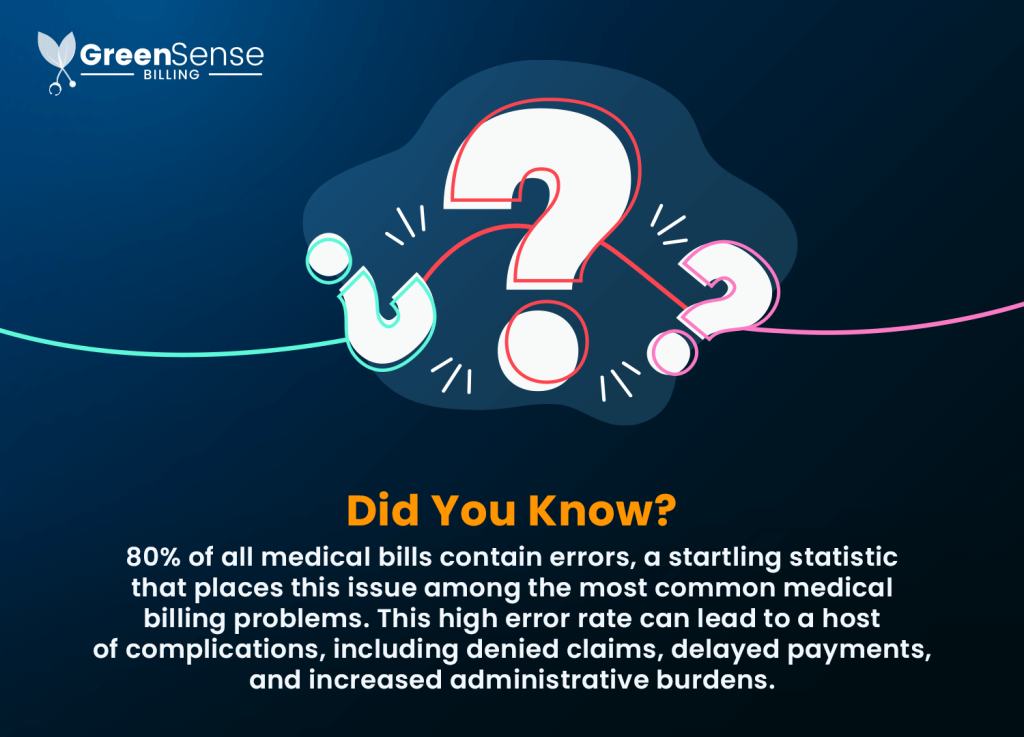
Things don’t end with just three problems. There are a lot more hurdles that will come to pass. Some of them include:
-
Accuracy in Coding and Documentation
One of the pillars of successful billing in healthcare is the accuracy of coding and documentation.
Incorrect or incomplete coding are two most common medical billing errors that lead to claim denials or underpayments. The Healthcare Information and Management Systems Society (HIMSS) reports that coding errors significantly contribute to approximately 80% of claim denials.
Invest in expertise and regular audits. Employ certified medical coders who are well-versed in ICD-10, CPT, and HCPCS codes. Regular audits of coding practices can identify areas for improvement, reducing the likelihood of errors. Additionally, leveraging AI-powered coding tools can enhance accuracy and efficiency.
-
Complex Preauthorization Process
Preauthorization is an important step in the billing process, particularly for procedures and treatments requiring insurance approval.
A study by the American Medical Association (AMA) found that 1 in 3 providers reported that preauthorization delays led to a serious adverse event for a patient in their care. This statistic not only highlights a patient safety concern but also underscores the administrative burden on healthcare providers.
Efficient workflow and technology integration can help with that. Develop a streamlined workflow for handling preauthorizations.
Utilize technology to track and manage preauthorization requests. Integrating preauthorization software like Myndshft or CoverMyMeds Platform, with your EHR system can reduce manual errors and speed up the process.
-
Complexity of Out-of-Network Billing
Out-of-network billing presents another significant challenge. Patients often find themselves inadvertently receiving services from out-of-network providers, leading to higher bills and dissatisfaction.
For providers, this means navigating a maze of different insurance plans and reimbursement rates.
Solution: Transparent Communication and Network Expansion.
Ensure patients are informed about network statuses and potential costs. Work towards expanding your network agreements to include a wider range of insurance plans, reducing the frequency of out-of-network billing issues.
-
Leveraging Technology for Efficient Billing
The role of technology in streamlining healthcare billing problems cannot be overstated. A report by Grand View Research noted that the healthcare revenue cycle management market is expected to grow significantly, driven by technological advancements.
Therefore, it is important to embrace cutting-edge solutions.
Invest in advanced billing software that offers features like automated claim submissions, error checks, and real-time analytics. Utilizing cloud-based systems can also enhance accessibility and collaboration among your billing team.
-
Fostering a Culture of Continuous Improvement
Lastly, a culture of continuous improvement is essential to address billing challenges timely. This involves not just keeping up with industry changes, but actively seeking ways to enhance billing processes.
Regular training and feedback loops are important for that. Conduct regular training sessions for your staff on the latest billing practices and technologies.
Establish feedback loops where staff can report challenges and suggest improvements, fostering a proactive approach to problem-solving.
You can also hire virtual staff that can train your in-house assistants or help you navigate the billing and revenue cycle challenges.
The Lighter Side of Billing Woes: Some Relatable Moments in Healthcare
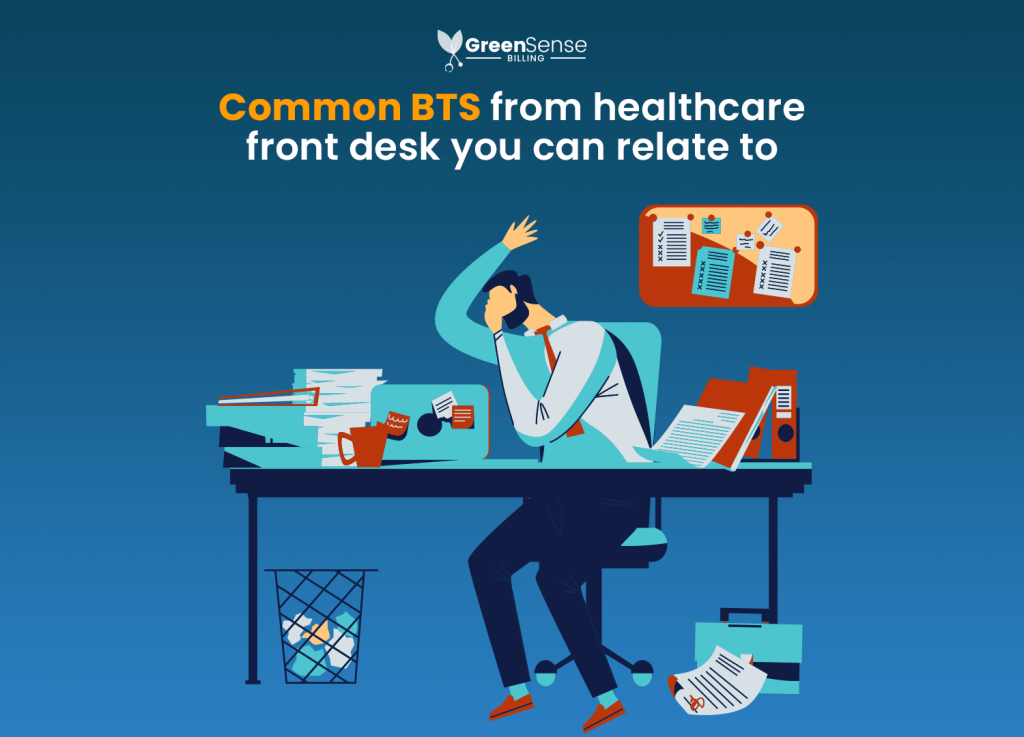
Amidst the serious challenges of healthcare billing, there are times we get lost in the real maze. The maze that is complicated yet makes us laugh.
Let’s recall some of these instances.
Such as:
The Denied Claim Déjà Vu
There’s a special kind of déjà vu that comes with seeing a claim denied for the umpteenth time. It’s like Groundhog Day, but instead of Bill Murray, it’s a rejected claim form staring back at you. You start wondering if the insurance company has a “deny” button they hit just for fun. But, like a determined hero in a movie, you resubmit, ready to face the challenge head-on.
Lost in Translation Episodes
Everyone can relate to this.
Ever had a patient describe their symptoms in a way that leaves you scrambling for a code? They say, “It feels like there’s a small alien dancing in my stomach,” and you’re left wondering if there’s a code for extraterrestrial abdominal activities. Translating unique patient descriptions into standardized medical codes can sometimes feel like deciphering an ancient language.
The Surprise Billing Party
Then there’s the surprise billing party – when a patient receives an unexpected bill, and you’re just as surprised as they are.
It’s like throwing a party nobody knew they were attending. Balloons and confetti are replaced with confusion and phone calls, trying to figure out where things went sideways. But then there’s an even bigger surprise when they pay those bills on time! Such a mix of happy and shocking feelings.
While the challenges of billing in a healthcare office are real and often stressful, slowing down and getting external help can be a helpful coping mechanism. It’s important to remember that behind every bizarre billing code, every perplexing patient description, there’s an opportunity to learn, grow, and maybe even share a laugh. By tackling these challenges promptly, you can navigate the complex world of medical billing issues with resilience and a smile. What else do you need?
We are not saying payments. Are you?
Wrapping Up
The challenges of billing in a healthcare office are multifaceted, but not insurmountable. By focusing on areas like coding accuracy, streamlining preauthorization, managing out-of-network billing, credentialing, leveraging technology, and fostering a culture of continuous improvement, you can significantly enhance your billing processes.
These steps not only improve the financial health of your practice but also contribute to better patient care and satisfaction. In the ever-evolving landscape of healthcare, staying ahead in billing practices is not just beneficial – it’s essential.




